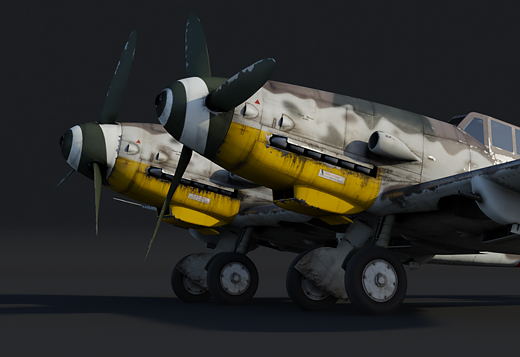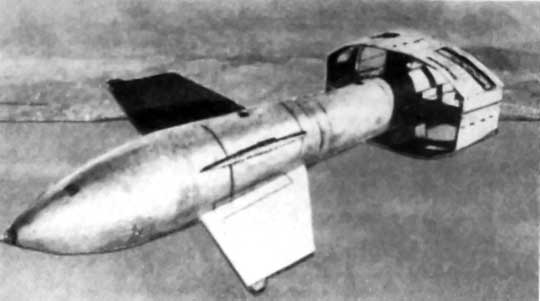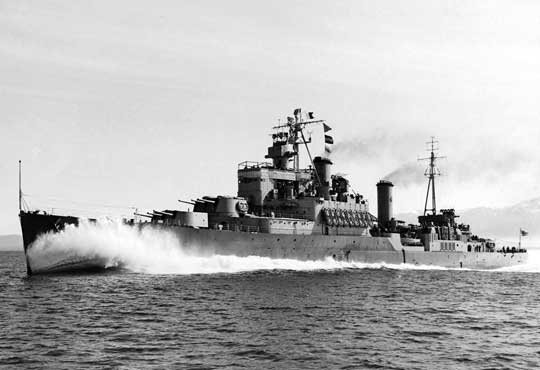
Triple Fritz-X

Italian battleship Roma shortly after construction.
In the second half of the 30s, it was still believed that the most heavily armored ships would determine the outcome of hostilities at sea. The Germans, with far fewer such units than the British and French, had to rely on the Luftwaffe to help close the gap if needed. Meanwhile, the participation of the Condor Legion in the Spanish Civil War made it possible to find out that even under ideal conditions and with the use of the latest sights, hitting a small object is rare, and even rarer when it is moving.
This was not much of a surprise, so Junkers Ju 87 dive bombers were also tested in Spain, with much better drop results. The problem was that these aircraft had too short a range, and the bombs they could carry could not penetrate the horizontal armor into the critical compartments of the attacked ships, that is, into the ammunition and engine rooms. The solution was to accurately drop as large a bomb (carrying vehicle equipped with at least two engines) as possible from the highest possible height (which greatly limited the flak threat) while providing sufficient kinetic energy.
The results of the experimental attacks by select crews of the Lehrgeschwader Greifswald had a clear meaning - although the radio-controlled target ship, the former battleship Hessen, 127,7 m long and 22,2 m wide, maneuvered gently and at a speed of no more than 18 knots, with an accuracy of 6000-7000 m when dropped bombs was only 6%, and with an increase in height to 8000-9000 m, only 0,6%. It became clear that only guided weapons could give the best results.
The aerodynamics of the free-falling bomb, which was aimed at the target by radio, was carried out by a group from the German Institute for Aeronautical Research (Deutsche Versuchsanstalt für Luftfahrt, DVL), based in Berlin's Adlershof district. It was headed by Dr. Max Cramer (born 1903, graduate of the Munich University of Technology, with a Ph.D. obtained at the age of 28 thanks to scientific work in the field of aerodynamics, the creator of patented solutions for aircraft construction, for example, in relation to flaps, an authority in the field of laminar dynamics flow), which in 1938, when the new commission of the Reich Aviation Ministry (Reichsluftfahrtministerium, RLM) came, worked, among other things, on a wire-guided air-to-air missile.

The Fritz-X guided bomb is still in the level flight phase shortly after being removed from the suspension.
It didn't take long for Kramer's team, and testing of the SC 250 DVL ring-tail demolition bomb was so successful that the decision was made to make the PC 1400 a "smart" weapon, one of the largest heavy bomb targets in the world. Arsenal of the Luftwaffe. It was produced by the Ruhrstahl AG plant in Brakwede (Bielefeld area).
The radio bomb control system was originally developed at the RLM research center in Gröfelfing near Munich. Tests of the devices built there, carried out in the summer of 1940, did not bring satisfactory results. Specialists from the teams of Telefunken, Siemens, Lorenz, Loewe-Opta and others, who initially only dealt with parts of the project in order to keep their work secret, did better. Their work resulted in the creation of the FuG (Funkgerät) 203 transmitter, codenamed Kehl, and the FuG 230 Strassburg receiver, which lived up to expectations.
The combination of the bomb, plumage and guidance system received the factory designation X-1, and the military - PC 1400X or FX 1400. As in the lower ranks of the Luftwaffe, the “ordinary” 1400-kilogram bomb was nicknamed Fritz, the term Fritz-X became popular, which they adopted later through their allied intelligence services. The place of production of new weapons was a plant in the Berlin district of Marienfelde, which was part of the Rheinmetall-Borsig concern, which received a contract for its construction in the summer of 1939. The first prototypes began to come out of these factories. in February 1942 he went to Peenemünde West, the Luftwaffe test center on the island of Usedom. By 10 April, 111 Fritz-Xs had been withdrawn from operational Heinkli He 29H hosts based in nearby Harz, with only the last five considered satisfactory.
The next series, at the beginning of the third decade of June, gave the best results. The target was a cross marked on the ground, and 9 out of 10 bombs dropped from 6000 meters fell within 14,5 meters of the crossing, three of which were almost over it. Since the main target was battleships, the maximum width of the hull amidships was about 30 meters, so it is not surprising that the Luftwaffe decided to include new bombs in the armament of the Luftwaffe.
It was decided to conduct the next stage of testing in Italy, which assumed a cloudless sky, and from April 1942, the Heinkle took off from the Foggia airfield (Erprobungsstelle Süd). During these tests, problems arose with electromagnetic switches, so work was started on pneumatic activation in the DVL (the system was supposed to supply air from a grip on the bomb body), but Cramer's subordinates, after testing in a wind tunnel, went to the source of the problem and electromagnetic activation was preserved. After the defect was eliminated, the test results got better and better, and as a result, out of about 100 bombs dropped, 49 fell on the target square with a side of 5 m. The failures were due to the poor quality of the “product”. or operator error, i.e. factors that are expected to be eliminated over time. On August 8, the target was an armor plate 120 mm thick, which the warhead of the bomb pierced smoothly without any special deformations.
Therefore, it was decided to move on to the stage of developing methods for the combat use of new weapons with target carriers and pilots. At the same time, RLM placed an order with Rheinmetall-Borsig for serial Fritz-X units, requiring delivery of at least 35 units per month (the goal was to be 300). Various kinds of blockages of material (due to the lack of nickel and molybdenum, it was necessary to look for another alloy for the heads) and logistics, however, led to the fact that such efficiency was achieved in Marienfeld only in April 1943.
Much earlier, in September 1942, a training and experimental unit (Lehr- und Erprobungskommando) EK 21 was created at the Harz airfield, flying Dornier Do 217K and Heinklach He 111H. In January 1943, already renamed Kampfgruppe 21, it had four Staffeln Dornier Do 217K-2s only, with Fritz-X mounts and Kehl III version transmitters. On April 29, EK 21 officially became a combat unit, renamed III./KG100 and based at Schwäbisch Hall near Stuttgart. By mid-July, her move to the Istres airfield near Marseille was completed, from where she began sorties.
Augusti do Romi
On July 21, three Dorniers from Istria were sent to attack Augusta (Sicily), a port captured by the Allied forces eight days earlier. The bombers arrived at their destination already at dusk and did not turn anything. A similar raid on Syracuse two days later ended the same way. Four III./KG31 bombers took part in a large scale attack against Palermo on the night of 1 July/100 August. A few hours earlier, a group of US Navy ships entered the port, providing an amphibious landing in Sicily, consisting of two light cruisers and six destroyers, on the roadstead of which transport workers with troops were waiting. The four from Istria reached their destination just before dawn, but it is not clear if they were successful.
The commanders of the minesweepers "Skill" (AM 115) and "Aspiration" (AM 117), which received damage from close explosions (the latter had a hole of about 2 x 1 m in the fuselage), wrote in their reports that the bombs were dropped from aircraft flying on a large height. However, it is certain that the 9th Staffel KG100 lost two vehicles shot down by enemy night fighters (probably these were Beaufighters of 600 Squadron RAF based in Malta). One pilot from the Dornier crews survived and was taken prisoner, from whom the scouts received information about a new threat.
This was not a complete surprise. The first warning was a letter received on 5 November 1939 by the British Naval Attaché in the Norwegian capital and signed "a German scientist on your side." Its author was Dr. Hans Ferdinand Maier, head of the research center of Siemens & Halske AG. The Briton found out about it in 1955 and, because he wanted to, did not reveal it until the death of Mayer and his wife, 34 years later. Although some information "treasures" made it more reliable, it was extensive and unequal in quality.
The Oslo Report was viewed with distrust. So the part about "remote controlled gliders" for anti-ship craft dropped from aircraft flying at high altitude was left out. Mayer also gave some details: the dimensions (each 3 m long and span), the frequency band used (short waves) and the test site (Penemünde).
However, in subsequent years, British intelligence began to receive "taunts" over "objects Hs 293 and FX", which in May 1943 confirmed the decoding of Bletchley Park's order to release them from warehouses and carefully protect them from espionage and sabotage. At the end of July, thanks to the decryption, the British learned about the readiness for combat missions of their aircraft carriers: Dornierów Do 217E-5 from II./KG100 (Hs 293) and Do 217K-2 from III./KG100. Due to ignorance at that time of the location of both units, warnings were sent only to the command of the naval forces in the Mediterranean.
On the night of 9/10 August 1943, four III./KG100 aircraft took to the air again, this time over Syracuse. Because of their bombs, the allies did not suffer losses, and Dornier, which belonged to the regular key, was shot down. The captured pilot and navigator (the rest of the crew died) during interrogations confirmed that the Luftwaffe had two types of radio-controlled weapons. It was not possible to extract information about the frequency from them - it turned out that before leaving the airport, pairs of crystals marked with numbers from 1 to 18 were simply put on the steering instruments, in accordance with the order received.
In the weeks that followed, the Dorniers of Istria continued to operate on a small scale and without success, usually participating in combined attacks with Ju 88s. Palermo (23 August) and Reggio Calabria (3 September). Own losses were limited to a wrench, which was destroyed by the explosion of his own bomb while flying over Messina.
On the evening of September 8, 1943, the Italians announced a truce with the Allies. According to one of its provisions, the squadron under the command of Adm. Carlo Bergamini, consisting of three battleships - the flagship Roma, Italia (ex-Littorio) and Vittorio Veneto - the same number of light cruisers and 8 destroyers, which were joined by a squadron from Genoa (three light cruisers and a torpedo boat). Since the Germans knew what their allies were preparing for, III./KG100 aircraft were put on alert, and 11 Dorniers were fired from Istra to attack. They reached the Italian ships after 15:00 pm when they reached the waters between Sardinia and Corsica.
The first drops were not accurate, causing the Italians to open fire and begin to evade. They were not effective - at 15:46 Fritz-X, having broken through the Roma's hull, exploded under its bottom, most likely on the border between the right and rear engine compartments, which led to their flooding. Bergamini's flagship began to fall off the formation, and 6 minutes after that, the second bomb hit the deck area between the 2-mm turret of the main artillery gun No. 381 and the forward 152-mm port side guns. The result of its explosion was the ignition of propellant charges in the chamber under the first (gases threw overboard a structure weighing almost 1600 tons) and, possibly, under tower No. 1. A huge column of smoke rose above the ship, it began to sink bow first, leaning towards the starboard side. It eventually capsized as a keel and broke at the point of the second impact, disappearing underwater at 16:15. According to the latest data, 2021 people were on board and 1393 people, led by Bergamini, died with it.

The light cruiser Uganda, the first British warship to take part in Operation Avalanche, was damaged by a direct guided bomb hit.
At 16:29 Fritz-X penetrated the deck of Italy and the side belt in front of turret 1, exploding in the water off the starboard side of the ship. This meant the formation of a hole in it measuring 7,5 x 6 m and deformation of the skin, extending to the bottom in an area of 24 x 9 m, but flooding (1066 tons of water) was limited to cofferdams between the skin and the longitudinal anti-torpedo bulkhead. Earlier, at 15:30, a bomb explosion in Italy's port stern resulted in a brief jamming of the rudder.
The first bomb that hit Roma was dropped from the aircraft of Major III./KG100 commander. Bernhard Jope, and the platoon guided her to the target. Klaproth. The second, from Dornier, piloted by Sgt. employees. Kurt Steinborn led the platoon. Degan.
